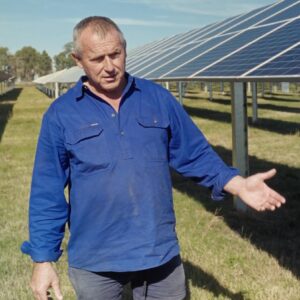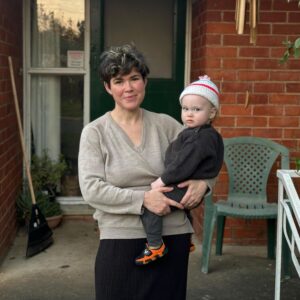
Reuben
“When it gets really hot at home on the weekends, we don’t have to worry so much about putting on the air conditioning because we know the power is coming from our solar panels.”
Reuben lives with his family in Western Sydney where it gets hot, hot, hot! Luckily, when they built their home four years ago, they were able to install rooftop solar, which makes managing heat and power bills easier.
Installing rooftop solar panels is one of the best investments you can make to keep your bills low in summer (and all year round). The average Aussie household saves around $1390 a year on their energy bills after installation.

Nicolas and Jingting
“We pay nothing for electricity through the summer, and our winter bills are much lower. Overall we are saving about 80% on our power bills.”
While most Australians’ energy bills have been rising fast, Nico and Jingting’s bills have become dramatically cheaper – even though their energy usage has gone up since their son Enzo joined the family.
A few years ago, they installed solar panels on their roof, buoyed by the savings on their electricity they decided to convert their entire home to run on cheap, renewable energy. While they saved for the renovation they used a portable induction to cut their gas bill.
Soon they were able to make more permanent upgrades, swapping to more efficient appliances, adding an induction cooktop in the kitchen and replacing their gas hot water with a heat pump hot water system. Combined with more mindful electricity usage the family has been able to significantly ease their cost of living.
“Now we have a new kitchen with an installed induction cooktop, but the portable cooktop was really affordable and easy to use until we did the kitchen renovation.”
But many Australians have not been so lucky and are missing out on the opportunity to slash their bills, left at the mercy of market fluctuations and price gouging by private energy companies. People in regional Australia, low and middle-income earners, renters, apartment dwellers, and marginalised communities are being left behind without fair access to the benefits of solar and energy efficiency.
The good news is, with urgent investment from our government to reduce the cost of home energy upgrades, rooftop solar, and batteries now, we could expand access those households that have been locked out until now and give more Aussie families the chance to cut their energy bills for good, just like Nico and his family did.

Tony
Grazing under the panels – why regional Australia needs local energy hubs
When merino wool grower Tony Inder could see green grass under the panels of the solar farm that had been built next door to his farm, while his side was dry, he asked if he could put some sheep in to help with mowing costs.
The sixth-generation western NSW farmer’s idea to graze his sheep under solar farms has seen the quality of the wool improve and yields increase by 20%.
But it hasn’t all been easy. Even though renewables are helping to save family farms by generating regular income so they remain profitable, even through periods of rising costs, drought and flood, many don’t know what’s possible and there is little support available.
That’s why Tony is calling for Local Energy Hubs – outreach centres staffed by respected local people who are independent from industry, that support communities in understanding and participating in the shift to renewable energy.
“If there had been a Local Energy Hub, it would’ve helped us and it would’ve made our decision making it a lot simpler.”
“It wasn’t something that you could walk into the local pub and say ‘G’day fellas, anyone know anything about solar, I’m going to sign the farm up?’ You’d have got run out of town.”
But Tony persisted – and solar grazing is benefitting both his farming operation, and the running of the solar farm. Sheep keep the grass down, saving on maintenance costs. And the panels promote better pasture growth, because of the rain effect produced by condensation. Tony’s stocking rates have gone up because he’s got more feed and he’s producing better quality wool under the panels.
“The sheep just do really well. I like to say that panel sheep are happy sheep.”

Ada
When Ada, a public servant living in Canberra, became pregnant, she worked hard to find an energy-efficient home. Despite her best efforts, she ended up in a poorly insulated and draughty house with extortionate energy bills.
“The World Health Organisation recommends a minimum of 18 degrees for a baby. I had to use an electric heater to keep the nursery around 19-20 degrees. Our combined electricity and gas bill for that winter was $1200,” she remembers.
She continued to search, and secured an older brick house that retains heat better, significantly improving her and her son’s quality of life.
“This winter, in the new house with ceiling insulation, it’s the little things—like walking to the bathroom in the middle of the night without it being unpleasant—that make a big difference,” she explains.
“Rather than constantly having to meet elsewhere, getting the baby out of the house, I can invite people over. Having a place that’s homely, warm, welcoming—it shouldn’t be such a treat, but it really is.”
Ada’s story is just one of many. Many renters still face the same challenges—dealing with extreme energy bills, cold homes, and the health risks that come with them. As climate change drives more extreme weather, the situation could get even worse—with low-income and marginalised communities bearing the brunt.
However, with early and decisive government intervention, things could get better instead.
Simple measures like better insulation, upgrading heating systems, energy-efficient appliances, and accessible grants to make these upgrades affordable could keep homes safe and warm, saving households thousands. It’s essential that everyone—especially renters, those in social housing, and people in regional areas—has access to these solutions. With the right actions, every home can be a place where families like Ada’s can thrive.

Ken
Ken’s “electrification journey” began about 17 years ago when they put an induction cooktop into their home kitchen in Sydney.
“Someone said it’s new, it’s a really good way to cook, very quick, it doesn’t use a lot of power. So we thought, “okay we will give it a go.”
After that they started placing solar panels on their house.
They did experience one problem: shading in winter.
So they popped in some more panels on top of their garage – this time with individual converters – which optimise the power output of each panel. Now they have enough power to run their house during the day.
“I would certainly have enough power to run the house at night if I had a battery.”
“It’s good for my power bills and it’s great for the planet. It’s a win-win situation.”

Thelma
Thelma has been a foster carer for 25 years. She is a pensioner, works at Mt Gravatt community centre and lives in public housing.
She has had to put in an air conditioner and overhead fans because the house is freezing in winter and boiling in summer
A couple of months ago, she was contacted by her electricity provider who said that she owed $690.
“That had to come out of my pension which left me just over $200 to buy food for myself and the child in my care at a time.”
“If we had solar panels like my neighbour does – who hasn’t had a bill in four years – it would be so much easier for me.”
Thelma wants support for renter and public housing tenants to help them install solar panels to help with the cost of living.
